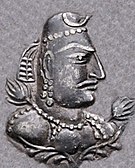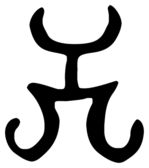
Back هان الخون Arabic Alchon German آلخون Persian Alkhon French הונים אלכונים HE Unni Alcioni Italian 알촌 Korean Alchon Dutch Alchons Occitan الچون ہن PNB
Alchon Huns | |
|---|---|
| 370–670 | |
Portrait of Alchon king Khingila (c. 450 CE), and the bull/lunar tamga of the Alchon (known as Tamgha S1),[1] as visible on Alchon coinage.
| |
Find spots of epigraphic inscriptions (red dots) indicating local control by the Alchon Huns in India between 500-530 CE,[2] with neighbouring polities,[3] and territorial extent of the Alchon Huns (brown).[4] | |
| Capital | Kapisa Udabhanda[5] Sagala[6][7] |
| Common languages | Brahmi and Bactrian (written) |
| Religion | Hinduism Buddhism Zoroastrianism[8] |
| Government | Nomadic empire |
| Historical era | Late antiquity |
• Established | 370 |
• Disestablished | 670 |
| Currency | Drachm |
| Today part of | Afghanistan Pakistan India |
The Alchon Huns, (Bactrian: αλχον(ν)ο Alkhon(n)o or αλχαν(ν)ο Alkhan(n)o) also known as the Alkhan, Alchono, Alxon, Alkhon, Alakhana, and Walxon, were a nomadic people who established states in Central Asia and South Asia during the 4th and 6th centuries CE.[1] They were first mentioned as being located in Paropamisus, and later expanded south-east, into the Punjab and Central India, as far as Eran and Kausambi. The Alchon invasion of the Indian subcontinent eradicated the Kidarite Huns who had preceded them by about a century, and contributed to the fall of the Gupta Empire, in a sense bringing an end to Classical India.[9][5]
The invasion of India by the Huna peoples follows invasions of the subcontinent in the preceding centuries by the Yavana (Indo-Greeks), the Saka (Indo-Scythians), the Pahlava (Indo-Parthians), and the Kushana (Yuezhi). The Alchon Empire was the second of four major Huna states established in Central and South Asia. The Alchon were preceded by the Kidarites and succeeded by the Hephthalites in Bactria and the Nezak Huns in the Hindu Kush. The names of the Alchon kings are known from their extensive coinage, Buddhist accounts, and a number of commemorative inscriptions throughout the Indian subcontinent.
The Alchons have long been considered as a part or a sub-division of the Hephthalites, or as their eastern branch, but now tend to be considered as a separate entity.[1][10][11]
- ^ a b c Rezakhani 2017, pp. 105–124.
- ^ Bakker 2020.
- ^ Schwartzberg, Joseph E. (1978). A Historical atlas of South Asia. Chicago: University of Chicago Press. p. 25. ISBN 0226742210.
- ^ Schwartzberg, Joseph E. (1978). A Historical atlas of South Asia. Chicago: University of Chicago Press. p. 145, map XIV.1 (k). ISBN 0226742210.
- ^ a b Bakker, Hans (2017), Monuments of Hope, Gloom and Glory in the Age of the Hunnic Wars: 50 years that changed India (484–534), Royal Netherlands Academy of Arts and Sciences, Section 4, ISBN 978-90-6984-715-3, archived from the original on 11 January 2020, retrieved 20 May 2019
- ^ Bakker, Hans (16 July 2014). The World of the Skandapurāṇa. BRILL. ISBN 9789004277144.
- ^ Dani, Ahmad Hasan (1999). History of Civilizations of Central Asia: The crossroads of civilizations: A.D. 250 to 750. Motilal Banarsidass. ISBN 9788120815407.
- ^ Jäger, Ulf. "A Unique Alxon-Hunnic Horse-and-Rider Statuette (Late Fifth Century CE) from Ancient Bactria / Modern Afghanistan in the Pritzker Family Collection, Chicago" (PDF). Sino-Platonic Papers. Archived (PDF) from the original on 4 April 2022. Retrieved 16 February 2023.
- ^ "The Alchon Huns....established themselves as overlords of northwestern India, and directly contributed to the downfall of the Guptas" in Neelis, Jason (2010). Early Buddhist Transmission and Trade Networks: Mobility and Exchange Within and Beyond the Northwestern Borderlands of South Asia. BRILL. p. 162. ISBN 9789004181595.
- ^ "Note 8: It is now clear that the Hephtalites were not part of those Huns who conquered the land south of the Hindu-Kush and Sind as well in the early 6th century. In fact, this latter Hunnic group was the one commonly known as Alkhon because of the inscriptions on their coins (Vondrovec, 2008)."
- ^ Rezakhani, Khodadad (2021). "From the Kushans to the Western Turks". King of the Seven Climes: 207.



